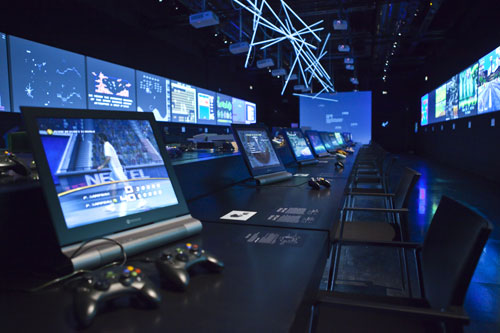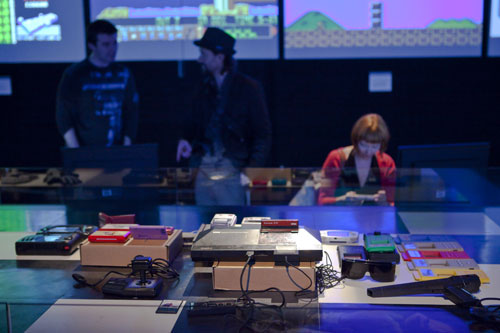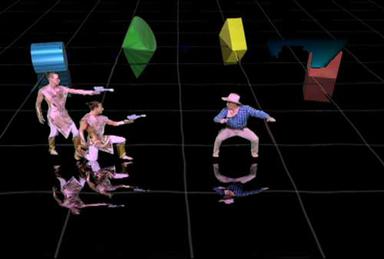J’ai été invité par la très respectable Poptronics à participer dans cette très belle exposition. Pour la partie « entretiens » de l’exposition, on m’a demandé de revisiter le brouhaha moche autour d’Invaders!. Puis on m’a posé des questions sur le vieux débat soupirs des relations (ou pas) entre art + jeux. Aussi je suis en bonne compagnie : des gens sympathiques comme Nicolas Nova, Invader, Isabelle Arvers, Frédérick Raynal, etc.

Update (22/11/2010). This exhibit has just been extended for another 6 months, due to it’s popularity.
- Exhibit: Museogames
- Location: Musée des Arts et métiers, Paris
- Map: 60 Rue Réaumur 75003 Paris
- Curators: Pierre Giner, Stéphane Natkin, Loïc Petitgirard
- Scenography: Traffik
- Editorial content: Annick Rivoire
- Date+Time: 22 June 2010 - 13 March 2011; 10h-18h; Closed on Mondays
- Interviews:
- Game History: Nicolas Nova, Philippe Dubois, Stéphane Natkin
- Game Industry: Sophie Pène, Peter Molyneux, David Cage, Hideo Kojima, Philippe Ulrich
- Game Culture: Isabelle Arvers, Olivier Séguret, Douglas Edric Stanley, Invader
- Game Users: Frédérick Raynal, Milad Doueihi, Laurent Trémel, Gonzalo Frasca
- Conférences:
- Jeudi 17 juin 2010 de 18h30 à 20h; « Serious games : apprendre grâce aux jeux vidéo ? » - Julian Alvarez, Valérie Boudier, Jean Menu, Stéphane Natkin
- Jeudi 2 septembre 2010 de 18h30 à 20h; « Histoire des jeux vidéo » - Daniel Ichbiah et Florent Gorges
- Jeudi 30 septembre 2010 de 18h30 à 20h; « Les jeux vidéo jouent de nos émotions » - Stéphane Natkin, David Cage, Eric Viennot
- Jeudi 28 octobre 2010 de 18h30 à 20h; « Et l’homme créa son double virtuel » - Catherine Pelachaud, Annie Gentes
- Playable consoles/games: Atari 2600 – Pacman, Atari 2600 - Missile Command, CBS Colecovision - Donkey Kong, MB Vectrex - Minestorm, MSX - Nemesis, Atari 520 ST - Arkanoid, Amiga 500 - Lemings, Nintendo NES - Super mario bros, SEGA Master System - Alex Kidd, SEGA Megadrive - Sonic, Nintendo Super Nintendo - Super Mario Kart, SNK NeoGeo - Metal Slug, Atari Jaguar - Rayman, SEGA Saturn - SEGA Rally Championship, Sony PlayStation - Tekken, Nintendo N64 - GoldenEye 007, SEGA Dreamcast - REZ, Sony PlayStation2 - Okami, Microsoft XBOX - Top Spin, Nintendo GameCube - Star Wars Rogue Leader, Nintendo Game Boy - Tetris


I’m particularly interested in the scenography of the exhibit which attempts a mise en scène of the both the public and private act of old skool gaming. Video games have over the years often been constructed as a very private act — not all that different from the act of reading —, while at the same time utilizing explicitly shared media such as the family television set as its transmission device. Even in the context of collective gameplay the ultra-tricked-out PC often encloses the gamer through various devices, in an attempt to surround the gamer within their specific perspective of the game world/gameplay. The Gameboy of course created the ultimate template for this enclosure and will further cement this relationship via the 3ds. And yet simultaneously, this configuration has very much been called into question, thanks to phenomena such as Guitar Hero/Rock Band or Nintendo’s own Wii.


The question therefore become, how to expose such a configuration; how to exhibit the game as both image-sound media object and human-computer apparatus. This is not only a question of gameplay, although there is of course that aspect as well: we cannot very well pretend to exhibit the video game as cultural artifact without in some way exposing its various forms gameplay from within the immersive shell. But it is also the notion of another form of shared configuration, specifically of the human-computer embrace that takes place when we sit down and pick up the joystick in its invitation to play. There is an interesting spectacle in that embrace, or at least when considered as a phenomenon in and of itself.

There are also a few other curiosity pieces, such as Sega’s stereo-laserdisc « Time Traveller) » which I was actually able to play a few weeks ago at California Extreme 2010. It’s a strange pseudo « Hollogram » device, which plays more or less like laserdisc classics such as Dragon’s Lair. The cheez-y gameplay sucks, but of course you knew that already. Nevertheless it sure feels like an under-explored technology that I wouldn’t be surprised to see recycled in some modified form over the next few years.



Original Comments:
TM
Hooo je me souviens du jeu avec le cowboy! C’etait vraiment special, rien avoir avec les arcades de l’epoque.